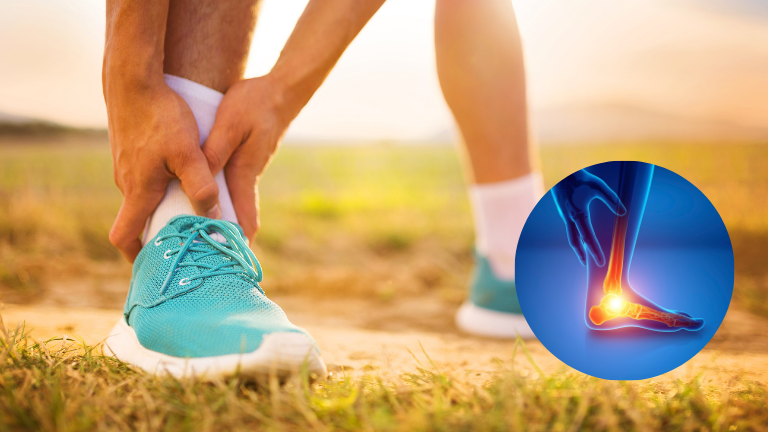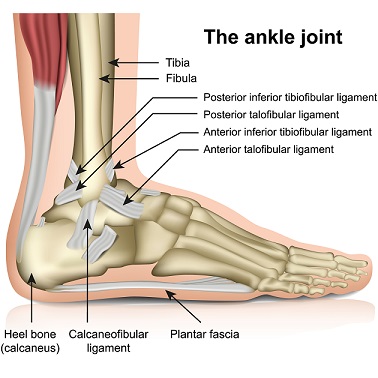
Ankles – The Unsung Heroes
When it comes to Pilates, we often focus on core strength, flexibility, and overall body alignment. However, there’s one crucial player that deserves more attention – our ankles. These joints play a pivotal role in our Pilates practice and daily movement. In this article, we’ll explore what makes up the ankle joints, why ankles are essential to the body and introduce specific Pilates exercises designed to strengthen and support these unsung heroes.

The ankle joint is a complex structure that allows for the movement of the foot. It is formed by the articulation of three bones: the tibia, fibula, and talus. Together, these bones create a hinge joint, also known as a talocrural joint, which facilitates dorsiflexion (flexing the foot upward) and plantarflexion (pointing the foot downward). Additionally, the ankle joint contributes to inversion (turning the sole of the foot inward) and eversion (turning the sole of the foot outward) movements.
Poor ankle mobility and strength can have a cascading effect on various aspects of your body’s biomechanics, leading to several unwanted consequences. Here are some potential issues associated with inadequate ankle mobility and strength:
- Impaired Balance and Stability:
– Weakened ankle muscles and limited mobility can compromise your ability to maintain balance, increasing the risk of falls and injuries during everyday activities and exercise routines. - Decreased Range of Motion:
– Poor ankle mobility restricts the range of motion in your lower limbs, affecting activities such as walking, squatting, and climbing stairs. This limitation may lead to compensatory movements in other joints, potentially causing pain or discomfort. - Altered Gait Patterns:
– Ankle dysfunction can result in altered walking patterns, affecting the biomechanics of your entire lower extremity. This can lead to overuse of other joints, such as the knees and hips, potentially contributing to pain or injury in these areas. - Increased Risk of Sprains and Strains:
– Weak ankle muscles and limited mobility make the ankles more susceptible to sprains and strains. Reduced stability may result in an inability to control the ankle joint, leading to injuries during activities that involve changes in direction or uneven surfaces. - Compromised Joint Health:
– Inadequate ankle strength and mobility can contribute to joint stiffness and immobility. Over time, this may impact the health of the ankle joint and surrounding structures, potentially leading to conditions like osteoarthritis. - Foot and Ankle Pain:
– Weakness and limited mobility can contribute to pain in the feet and ankles. Conditions such as plantar fasciitis, Achilles tendonitis, or general foot discomfort may arise when the ankles are unable to support the body’s weight and movement effectively. - Muscle Imbalances:
– Poor ankle function can lead to muscle imbalances in the lower limbs. Overactive muscles compensate for the lack of strength and mobility in the ankles, potentially resulting in overuse injuries or discomfort in surrounding areas. - Impact on Athletic Performance:
– Athletes who rely on agility, quick changes of direction, and dynamic movements may experience a decline in performance if ankle mobility and strength are compromised. This can affect sports such as running, jumping, and team sports that require rapid and precise movements.
Addressing poor ankle mobility and strength through targeted exercises, stretching, and mobility drills can help mitigate ankle issues and contribute to overall joint health and functional movement. Here are a few Pilates exercises for stronger ankles that you can do at home:
- Toe Taps:
– Starting Position: Lie on your back with legs extended.
– Exercise: Lift one leg to a tabletop position, toes pointing towards the ceiling. Tap the toes down and lift back up.
– Repetitions: 3 sets of 12 taps on each leg. - Calf Raises:
– Starting Position: Stand with feet hip-width apart.
– Exercise: Lift your heels off the ground, rising onto the balls of your feet. Lower back down.
– Repetitions: 3 sets of 15 raises. - Ankle Circles:
– Starting Position: Sit comfortably on the mat with legs extended.
– Exercise: Lift one foot and draw circles with your toes, first clockwise, then counterclockwise.
– Repetitions: 2 sets of 10 circles in each direction on each foot. - Pilates Point and Flex:
– Starting Position: Sit or lie down comfortably.
– Exercise: Point your toes, then flex them back towards your shins.
– Repetitions: 3 sets of 15 repetitions. - Pilates Relevé:
– Starting Position: Stand with feet hip-width apart.
– Exercise: Rise onto the balls of your feet, lifting your heels. Lower back down.
– Repetitions: 3 sets of 12 relevés.
As we embark on our Pilates journey, let’s not forget the significance of ankle strength and mobility. Incorporating these targeted exercises into your routine will not only fortify your ankles but also enhance your overall Pilates experience. By nurturing our ankles, we lay the groundwork for a more stable, agile, and connected practice. Here’s to strong ankles and a solid foundation for our Pilates adventures!



Sorry, the comment form is closed at this time.